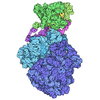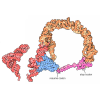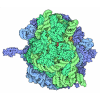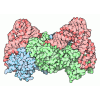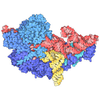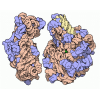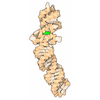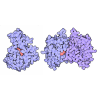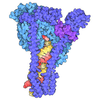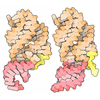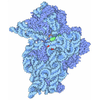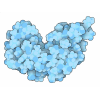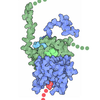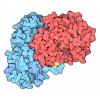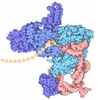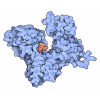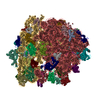+ Open data
Open data
- Basic information
Basic information
| Entry | Database: PDB / ID: 9h9m | |||||||||||||||||||||||||||||||||
|---|---|---|---|---|---|---|---|---|---|---|---|---|---|---|---|---|---|---|---|---|---|---|---|---|---|---|---|---|---|---|---|---|---|---|
| Title | Complex 4 (HEAD) 30S-GE81112 (weak residual tRNA) | |||||||||||||||||||||||||||||||||
 Components Components |
| |||||||||||||||||||||||||||||||||
 Keywords Keywords | RIBOSOME / Antibiotic / initiation factor / GE81112 / 30S | |||||||||||||||||||||||||||||||||
| Function / homology |  Function and homology information Function and homology informationtranscription antitermination factor activity, RNA binding / regulation of DNA-templated transcription elongation / transcription elongation factor complex / transcription antitermination / ribosome biogenesis / ribosomal small subunit assembly / small ribosomal subunit / cytosolic small ribosomal subunit / cytoplasmic translation / tRNA binding ...transcription antitermination factor activity, RNA binding / regulation of DNA-templated transcription elongation / transcription elongation factor complex / transcription antitermination / ribosome biogenesis / ribosomal small subunit assembly / small ribosomal subunit / cytosolic small ribosomal subunit / cytoplasmic translation / tRNA binding / negative regulation of translation / rRNA binding / structural constituent of ribosome / ribosome / translation / mRNA binding / RNA binding / zinc ion binding / membrane / cytoplasm / cytosol Similarity search - Function | |||||||||||||||||||||||||||||||||
| Biological species |  | |||||||||||||||||||||||||||||||||
| Method | ELECTRON MICROSCOPY / single particle reconstruction / cryo EM / Resolution: 3.1 Å | |||||||||||||||||||||||||||||||||
 Authors Authors | Schedlbauer, A. / Han, X. / van Bakel, W. / Kaminishi, T. / Ochoa-Lizarralde, B. / Iturrioz, I. / Capuni, R. / Parry, R. / Zegarra, R. / Gil-Carton, D. ...Schedlbauer, A. / Han, X. / van Bakel, W. / Kaminishi, T. / Ochoa-Lizarralde, B. / Iturrioz, I. / Capuni, R. / Parry, R. / Zegarra, R. / Gil-Carton, D. / Lopez-Alonso, J.P. / Barragan Sanz, K. / Brandi, L. / Gualerzi, C.O. / Fucini, P. / Connell, S.R. | |||||||||||||||||||||||||||||||||
| Funding support |  Spain, 1items Spain, 1items
| |||||||||||||||||||||||||||||||||
 Citation Citation |  Journal: bioRxiv / Year: 2024 Journal: bioRxiv / Year: 2024Title: A binding site for the antibiotic GE81112 in the ribosomal mRNA channel. Authors: Andreas Schedlbauer / Xu Han / Wouter van Bakel / Tatsuya Kaminishi / Borja Ochoa-Lizarralde / Idoia Iturrioz / Retina Çapuni / Ransford Parry / Ronny Zegarra / David Gil-Carton / Jorge P ...Authors: Andreas Schedlbauer / Xu Han / Wouter van Bakel / Tatsuya Kaminishi / Borja Ochoa-Lizarralde / Idoia Iturrioz / Retina Çapuni / Ransford Parry / Ronny Zegarra / David Gil-Carton / Jorge P López-Alonso / Kristina Barragan Sanz / Letizia Brandi / Claudio O Gualerzi / Paola Fucini / Sean R Connell /    Abstract: The initiation phase is the rate-limiting step of protein synthesis (translation) and is finely regulated, making it an important drug target. In bacteria, initiation is guided by three initiation ...The initiation phase is the rate-limiting step of protein synthesis (translation) and is finely regulated, making it an important drug target. In bacteria, initiation is guided by three initiation factors and involves positioning the start site on the messenger RNA within the P-site on the small ribosomal subunit (30S), where it is decoded by the initiator tRNA. This process can be efficiently inhibited by GE81112, a natural hydrophilic, noncyclic, nonribosomal tetrapeptide. It is found in nature in three structural variants (A, B and B1 with molecular masses of 643-658 Da). Previous biochemical and structural characterisation of GE81112 indicates that the primary mechanism of action of this antibiotic is to (1) prevent the initiator tRNA from binding correctly to the P-site and (2) block conformational rearrangements in initiation factor IF3, resulting in an 30S pre/C state. In this study, using cryoEM, we have determined the binding site of GE81112 in initiation complexes (3.2-3.7Å) and on empty ribosomes (2.09 Å). This binding site is within the mRNA channel (E-site) but remote from the binding site of the initiation factors and initiator tRNA. This suggests that it acts allosterically to prevent the initiator tRNA from being locked into place. The binding mode is consistent with previous biochemical studies and recent work identifying the key pharmacophores of GE81112. | |||||||||||||||||||||||||||||||||
| History |
|
- Structure visualization
Structure visualization
| Structure viewer | Molecule:  Molmil Molmil Jmol/JSmol Jmol/JSmol |
|---|
- Downloads & links
Downloads & links
- Download
Download
| PDBx/mmCIF format |  9h9m.cif.gz 9h9m.cif.gz | 457.3 KB | Display |  PDBx/mmCIF format PDBx/mmCIF format |
|---|---|---|---|---|
| PDB format |  pdb9h9m.ent.gz pdb9h9m.ent.gz | 337 KB | Display |  PDB format PDB format |
| PDBx/mmJSON format |  9h9m.json.gz 9h9m.json.gz | Tree view |  PDBx/mmJSON format PDBx/mmJSON format | |
| Others |  Other downloads Other downloads |
-Validation report
| Arichive directory |  https://data.pdbj.org/pub/pdb/validation_reports/h9/9h9m https://data.pdbj.org/pub/pdb/validation_reports/h9/9h9m ftp://data.pdbj.org/pub/pdb/validation_reports/h9/9h9m ftp://data.pdbj.org/pub/pdb/validation_reports/h9/9h9m | HTTPS FTP |
|---|
-Related structure data
| Related structure data |  51969MC  9h8gC  9h9hC  9h9iC  9h9jC  9h9kC  9h9lC  9h9nC M: map data used to model this data C: citing same article ( |
|---|---|
| Similar structure data | Similarity search - Function & homology  F&H Search F&H Search |
- Links
Links
- Assembly
Assembly
| Deposited unit | 
|
|---|---|
| 1 |
|
- Components
Components
-RNA chain , 1 types, 1 molecules 1
| #1: RNA chain | Mass: 499873.406 Da / Num. of mol.: 1 Source method: isolated from a genetically manipulated source Source: (gene. exp.)   |
|---|
-Small ribosomal subunit protein ... , 8 types, 8 molecules BCGIJMNS
| #2: Protein | Mass: 26781.670 Da / Num. of mol.: 1 Source method: isolated from a genetically manipulated source Source: (gene. exp.)   |
|---|---|
| #3: Protein | Mass: 26031.316 Da / Num. of mol.: 1 Source method: isolated from a genetically manipulated source Source: (gene. exp.)   |
| #4: Protein | Mass: 20055.156 Da / Num. of mol.: 1 Source method: isolated from a genetically manipulated source Source: (gene. exp.)   |
| #5: Protein | Mass: 14886.270 Da / Num. of mol.: 1 Source method: isolated from a genetically manipulated source Source: (gene. exp.)   |
| #6: Protein | Mass: 11755.597 Da / Num. of mol.: 1 Source method: isolated from a genetically manipulated source Source: (gene. exp.)   |
| #7: Protein | Mass: 13128.467 Da / Num. of mol.: 1 Source method: isolated from a genetically manipulated source Source: (gene. exp.)   |
| #8: Protein | Mass: 11606.560 Da / Num. of mol.: 1 Source method: isolated from a genetically manipulated source Source: (gene. exp.)   |
| #9: Protein | Mass: 10455.355 Da / Num. of mol.: 1 Source method: isolated from a genetically manipulated source Source: (gene. exp.)   |
-Non-polymers , 2 types, 43 molecules 


| #10: Chemical | ChemComp-MG / #11: Chemical | ChemComp-ZN / | |
|---|
-Details
| Has ligand of interest | N |
|---|---|
| Has protein modification | N |
-Experimental details
-Experiment
| Experiment | Method: ELECTRON MICROSCOPY |
|---|---|
| EM experiment | Aggregation state: PARTICLE / 3D reconstruction method: single particle reconstruction |
- Sample preparation
Sample preparation
| Component | Name: Complex 4 (HEAD) 30S-GE81112 / Type: RIBOSOME / Entity ID: #1-#9 / Source: NATURAL |
|---|---|
| Source (natural) | Organism:  |
| Buffer solution | pH: 7.7 |
| Specimen | Embedding applied: NO / Shadowing applied: NO / Staining applied: NO / Vitrification applied: YES |
| Specimen support | Grid type: Quantifoil R2/2 |
| Vitrification | Cryogen name: ETHANE |
- Electron microscopy imaging
Electron microscopy imaging
| Experimental equipment |  Model: Titan Krios / Image courtesy: FEI Company |
|---|---|
| Microscopy | Model: TFS KRIOS |
| Electron gun | Electron source:  FIELD EMISSION GUN / Accelerating voltage: 300 kV / Illumination mode: SPOT SCAN FIELD EMISSION GUN / Accelerating voltage: 300 kV / Illumination mode: SPOT SCAN |
| Electron lens | Mode: BRIGHT FIELD / Nominal defocus max: 3250 nm / Nominal defocus min: 500 nm |
| Image recording | Electron dose: 44.08 e/Å2 / Film or detector model: FEI FALCON III (4k x 4k) |
- Processing
Processing
| EM software |
| |||||||||||||||||||||||||||||||||||||||
|---|---|---|---|---|---|---|---|---|---|---|---|---|---|---|---|---|---|---|---|---|---|---|---|---|---|---|---|---|---|---|---|---|---|---|---|---|---|---|---|---|
| CTF correction | Type: PHASE FLIPPING AND AMPLITUDE CORRECTION | |||||||||||||||||||||||||||||||||||||||
| 3D reconstruction | Resolution: 3.1 Å / Resolution method: FSC 0.143 CUT-OFF / Num. of particles: 108310 / Symmetry type: POINT | |||||||||||||||||||||||||||||||||||||||
| Atomic model building | PDB-ID: 4ybb Accession code: 4ybb / Source name: PDB / Type: experimental model |
 Movie
Movie Controller
Controller










 PDBj
PDBj